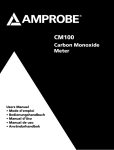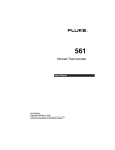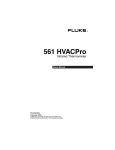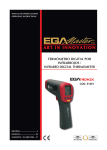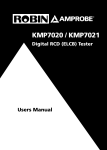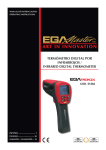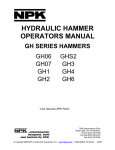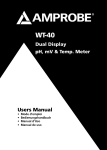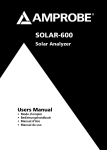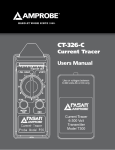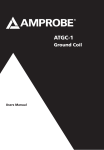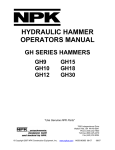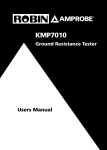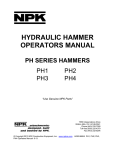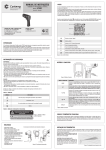Download Amprobe IR-712, IR-720, IR-730 Infrared Thermometers
Transcript
IR-712 12:1 IR Thermometer IR-720 20:1 IR Thermometer IR-730 30:1 IR Thermometer Users Manual • • • • • Mode d’emploi Bedienungshandbuch Manual d’Uso Manual de uso Användarhandbok IR-712 12:1 IR Thermometer IR-720 IR-730 30:1 IR Thermometer Users Manual September 2011, Rev.1 ©2011 Amprobe Test Tools. All rights reserved. Printed in China English 20:1 IR Thermometer Limited Warranty and Limitation of Liability Your Amprobe product will be free from defects in material and workmanship for 1 year from the date of purchase, unless local laws require otherwise. This warranty does not cover fuses, disposable batteries or damage from accident, neglect, misuse, alteration, contamination, or abnormal conditions of operation or handling. Resellers are not authorized to extend any other warranty on Amprobe’s behalf. To obtain service during the warranty period, return the product with proof of purchase to an authorized Amprobe Test Tools Service Center or to an Amprobe dealer or distributor. See Repair Section for details. THIS WARRANTY IS YOUR ONLY REMEDY. ALL OTHER WARRANTIES - WHETHER EXPRESS, IMPLIED OR STAUTORY - INCLUDING IMPLIED WARRANTIES OF FITNESS FOR A PARTICULAR PURPOSE OR MERCHANTABILITY, ARE HEREBY DISCLAIMED. MANUFACTURER SHALL NOT BE LIABLE FOR ANY SPECIAL, INDIRECT, INCIDENTAL OR CONSEQUENTIAL DAMAGES OR LOSSES, ARISING FROM ANY CAUSE OR THEORY. Since some states or countries do not allow the exclusion or limitation of an implied warranty or of incidental or consequential damages, this limitation of liability may not apply to you. Repair All test tools returned for warranty or non-warranty repair or for calibration should be accompanied by the following: your name, company’s name, address, telephone number, and proof of purchase. Additionally, please include a brief description of the problem or the service requested and include the test leads with the meter. Non-warranty repair or replacement charges should be remitted in the form of a check, a money order, credit card with expiration date, or a purchase order made payable to Amprobe® Test Tools. In-Warranty Repairs and Replacement – All Countries Please read the warranty statement and check your battery before requesting repair. During the warranty period any defective test tool can be returned to your Amprobe® Test Tools distributor for an exchange for the same or like product. Please check the “Where to Buy” section on www.amprobe. com for a list of distributors near you. Additionally, in the United States and Canada In-Warranty repair and replacement units can also be sent to a Amprobe® Test Tools Service Center (see address below). Non-Warranty Repairs and Replacement – US and Canada Non-warranty repairs in the United States and Canada should be sent to a Amprobe® Test Tools Service Center. Call Amprobe® Test Tools or inquire at your point of purchase for current repair and replacement rates. In USA In Canada Amprobe Test Tools Amprobe Test Tools Everett, WA 98203 Mississauga, ON L4Z 1X9 Tel: 877-AMPROBE (267-7623) Tel: 905-890-7600 Non-Warranty Repairs and Replacement – Europe European non-warranty units can be replaced by your Amprobe® Test Tools distributor for a nominal charge. Please check the “Where to Buy” section on www.amprobe.com for a list of distributors near you. European Correspondence Address* Amprobe® Test Tools Europe Beha-Amprobe GmbH In den Engematten 14 79286 Glottertal, Germany Tel.: +49 (0) 7684 8009 - 0 www.amprobe.eu *(Correspondence only – no repair or replacement available from this address. European customers please contact your distributor.) IR-712 12:1 IR Thermometer IR-720 20:1 IR Thermometer IR-730 30:1 IR Thermometer 4 1 2 3 1 Laser Aperture 2 Trigger 3 Battery Cover 10 6 5 4 Display 11 5 Laser “ON” symbol 14 7 9 8 12 6 Display backlight 7 Measurement lock (Continuous measurement) 8 Temperature unit (Celsius / Fahrenheit) 9 8 seconds auto display hold 10 Making measurement (Pulling the trigger) 11 Battery indicator 12 Primary display 15 13 13 Secondary display 14 Emissivity (Adjustable from 0.10 to 1.00) 15 MAX, MIN, DIF, AVG temperature values IR-712 12:1 IR Thermometer IR-720 20:1 IR Thermometer IR-730 30:1 IR Thermometer CONTENTS SYMBOL..................................................................................................................2 SAFETY INFORMATION..........................................................................................2 UNPACKING AND INSPECTION..............................................................................3 FEATURES................................................................................................................4 HOW THE THERMOMETERS WORK......................................................................5 OPERATING THE THERMOMETER..........................................................................5 Temperature Measurement . ............................................................................5 Locating a Hot or Cold Spot .............................................................................10 Distance and Spot Size . ....................................................................................11 Field of View......................................................................................................12 Emissivity............................................................................................................13 Reminders . ........................................................................................................13 TYPICAL MEASUREMENTS . ..................................................................................16 SPECIFICATION ......................................................................................................19 MAINTENANCE.......................................................................................................20 TROUBLE SHOOTING..............................................................................................21 BATTERY REPLACEMENT . .....................................................................................21 1 SYMBOLS � Caution! Refer to the explanation in this Manual. Warning! Laser light. Do not stare into laser beam. °C Celsius. °F Fahrenheit. Battery indication. � = Complies with European Directives. Do not dispose of this product as unsorted municipal waste. Contact a qualified recycler. SAFETY INFORMATION The instrument complies with: EN 61010-1 General Safety EN 60825-1 Laser Safety EN 61326-1 Electromagnetic Emissions and Susceptibility 2 �Warning • • • • • • • • • • Do not stare into laser beam. Do not point laser directly at eye or indirectly off reflective surfaces. For use by competent persons only. Do not point laser directly at eye or indirectly off reflective surfaces. Replace the batteries as soon as the low-battery indicator appears. Verify the Tester’s operation by measuring on a known voltage source. Do not use the thermometer if it operates abnormally. Do not operate the thermometer around explosive gas, vapor, or dust. To avoid a burn hazard or fire, know that reflective objects may be much hotter than the indicated temperature reading. Do not leave the thermometer on or near objects of high temperature. If the thermometer is used in a manner not specified by this manual, the protection provided by the thermometer may be impaired or may result in hazardous laser radiation exposure. �Cautions To avoid damaging the thermometer under measurement, protect them from the following: • EMF (electro-magnetic fields) from arc welders, induction heaters • Static electricity • Thermal shock (caused by large or abrupt ambient temperature changes — allow 30 minutes for instrument to stabilize before use) • Do not leave the thermometer on or near objects of high temperature Unpacking and Inspection Your shipping carton should include: 1 Thermometer (IR-712 or IR-720 or IR-730) 1 Carrying bag 1 9V battery (installed) 1 Users manual If any of the items are damaged or missing, return the complete package to the place of purchase for an exchange. 3 FEATURES The Amprobe IR-712, a 12:1 spot to distance ratio infrared thermometer, offers best in class accuracy and response time with a temperature measurement range of 0°F to 1022°F or -18°C to 550°C. The IR-712 is specifically designed for HVAC/R, electrical, industrial maintenance, automotive as well as quality control and fire prevention applications. • 12:1 Distance to Spot Ratio • Temp Range of 0°F to 1022°F or -18°C to 550°C • Precision accuracy and rapid response time • Laser pointer, backlit dual LCD Display • Auto display hold and MAX/MIN memory • Adjustable emissivity for measuring a variety of materials The Amprobe IR-720, a 20:1 spot to distance ratio infrared thermometer, offers best in class accuracy and response time with a temperature measurement range of -26°F to 1922°F or -32°C to 1050°C. The IR-720 is specifically designed for HVAC/R, electrical, industrial maintenance, automotive as well as quality control and fire prevention applications. • 20:1 Distance to Spot Ratio • Temp Range of -26°F to 1922°F or -32°C to 1050°C • Precision accuracy and rapid response time • Laser pointer, backlit dual LCD Display • Auto display hold and MAX/MIN memory • Adjustable emissivity for measuring a variety of materials The Amprobe IR-730, a 30:1 spot to distance ratio infrared thermometer, offers best in class accuracy and response time with a temperature measurement range of -26°F to 2282°F or -32°C to 1250°C. The IR-730 is specifically designed for HVAC/R, electrical, industrial maintenance, automotive as well as quality control and fire prevention applications. •30:1 Distance to Spot Ratio •Temp Range of -26°F to 1922°F or -32°C to 1050°C 4 •Precision accuracy and rapid response time •Laser pointer, backlit dual LCD Display •Auto display hold and MAX/MIN memory •Adjustable emissivity for measuring a variety of materials HOW THE THERMOMETERS WORK Infrared thermometers measure the surface temperature of an object. The thermometer’s optics sense emitted, reflected, and transmitted energy, which is collected and focused onto a detector. The unit’s electronics translate the signal into a temperature reading which the unit displays. OPERATING THE THERMOMETER Temperature Measurement The Thermometer turns on when you press the trigger The Thermometer turns off when no activity is detected for 8 seconds. To measure temperature, point the thermometer at an object and pull the trigger. You can use the laser pointer to help aim the thermometer. Pull and hold the trigger when measuring the target surface. When release the trigger, the display will hold the reading for 8 seconds. Be sure to consider distanceto-spot size ratio and field of view. The laser is used for aiming only and is not related to temperature measurement. The thermometer features an auto off function that automatically powers down the thermometer after 8 seconds of inactivity. To turn the thermometer on, pull the trigger. 5 Rotary Switch Positions Button Description MODE Press MODE button to toggle between MAX, MIN, DIF, and AVG options. When the Thermometer goes into sleep mode, press MODE to turn the Thermometer ON again and it displays the last measurement result. SET Press to enter set-up mode stepping through Emissivity, Trigger Lock and Switching oC/oF set-up. Details refer to the below Emissivity, Trigger Lock and °C / °F set-up.. / to turn the display backlight ON or OFF. Press When the Thermometer enters the setup up mode, press to select a set-up option (Emissivity, Trigger lock, Switching °C / °F). / Press to turn the laser light ON or OFF. When the Thermometer enters the setup up mode, press to select a set-up option (Emissivity, Trigger lock, Switching °C / °F). 6 Emissivity set-up 1.Press SET button to select Emissivity set-up, icon display is blinking on the to increase the value by 0.01. Press and hold 2.Press setting. The maximum value is 1.00. for quick to decrease the value by 0.01. Press and hold 3.Press setting. The minimum value is 0.01. for quick 4.Press MODE button to complete the setting and exit Emissivity set-up, or press SET button to complete the setting and continue setting for Trigger Lock. Note: Default emissivity is 0.95. Table of Surface Emissivity Measure Surface Switch Setting METALS Aluminum Oxidized 0.2 – 0.4 Alloy A3003 Oxidized 0.3 Roughened 0.1 – 0.3 Brass Burnished 0.3 Oxidized 0.5 Cooper Oxidized 0.4 – 0.8 Electrical Terminal Blocks 0.6 Haynes Alloy 0.3 – 0.8 Inconel Oxidized 0.7 – 0.95 Sandblasted 0.3 – 0.6 7 Electoropolished 0.15 Iron Oxidized 0.5 – 0.9 Rusted 0.5 – 0.7 Iron Cast Oxidized 0.6 – 0.95 Unoxidized 0.2 Molten 0.2 – 0.3 Iron Wrought Dull 0.9 Lead Rough 0.4 0.2 – 0.6 Oxidized Molydbenum Oxidized 0.2 – 0.6 Nickel Oxidized 0.2 – 0.5 Platinum Black 0.9 Steel Cold-Rolled 0.7 – 0.9 Ground Sheet 0.4 – 0.6 Polished Sheet 0.1 Zinc Oxidized 0.1 8 Measure Surface Switch Setting NON-METALS Asbestos 0.95 Asphalt 0.95 Basalt 0.7 Carbon Unoxidized 0.8 – 0.9 Graphite 0.7 – 0.8 Carborundum 0.9 Ceramic 0.95 Clay 0.95 Concrete 0.95 Cloth 0.95 Glass Plate 0.85 Gravel 0.95 Gypsum 0.8 – 0.95 Ice 0.98 Limestone 0.98 Paper (any colour) 0.95 Plastic Opaque 0.95 Soil 0.9 – 0.98 Water 0.93 Wood, (natural) 0.9 – 0.95 9 Trigger Lock The thermometer trigger can be locked on for continuous measurement. To lockthe trigger: 1.Press SET button to select Trigger Lock set-up, icon display 2.Press or is blinking on the to select ON or OFF. 3.Press MODE button to complete the setting and exit Trigger Lock set-up, or press SET button to complete the setting and continue setting for °C / °F. °C / °F Set-up 1.Press SET button to select °C / °F set-up, icon °C or °F is blinking on the display 2.Press or to select °C or °F. 3.Press MODE button to complete the setting and exit °C / °F set-up. Locating a Hot or Cold Spot To find a hot or cold spot, aim the Thermometer outside the target area. Then, slowly scan across the area with an up and down motion until you located the hot or cold spot. 10 Distance and Spot Size As the distance (D) from the target being measured increases, the spot size (S) of the area measured by the instrument becomes larger. The spot size indicates 90% encircled energy. 11 Field of View Make sure that the target is larger than the spot size. The smaller the target, the closer you should be to it. 12 Emissivity Emissivity describes the energy-emitting characteristics of materials. Most organic materials and painted or oxidized surfaces have an emissivity of about 0.95. If possible, to compensate for inaccurate readings that may result from measuring shiny metal surfaces, cover the surface to be measured with masking tape or flat black paint (<150°C / 302°F ) and use the high emissivity setting. Allow time for the tape or paint to reach the same temperatures as the surface beneath it. Measure the temperature of the tape or painted surface. If you cannot use paint or use tape, then you could improve the accuracy of your measurements with the emissivity selector. Even with emissivity selector, it can be difficult to get a completely accurate infrared measurement of a target with a shiny or metallic surface. The Thermometer allows you to adjust the emissivity for the type of surface before measured. Refer to Table of Surface Emissivity. But it is only a typical case. You could base on your own case and materials to have different setting. Reminders 1.Changes of surrounding ambient temperature can result in inaccurate reading, allow time for the instrument to adopt the change of ambient before use. Specified accuracy applies after 30 minutes when the instrument changes to a different environment ambient. 13 2.The instrument cannot measure through transparent surfaces such as glass. It will measure the surface temperature of the glass instead. 3.See table of Surface Emissivity for use in measuring shiny or polished metal surfaces (stainless steel, aluminum, etc.). 14 4.Steam, dust, smoke, etc., can prevent accurate measurement by obstructing the instrument’s optics. TYPICAL MEASUREMENTS This section describes a variety of measurements often performed by technicians. Reminder: • User could select to turn on or off the backlight and laser whenever you are making readings with the Thermometer. • Relatively high emissivity normally means emissivity setting of about 0.95. • Relatively low emissivity normally means emissivity setting of about 0.30. • When user cannot identify the emissivity of the object to be measured, user could cover the surface to be measured (temperature >150°C) with black electric tape (emissivity of about 0.95). Allow time for the tape to reach the same temperature as the object to be measured. Measure and record the temperature of the tape. Target the Thermometer to the object to be measured, adjust the emissivity setting to make it as the same temperature as the tape. At this time, the Thermometer emissivity setting is close to the emissivity of the object to be measured, measurement could be started. Testing Contactors (starters) 1.Press SET to select emissivity. Press / to select relatively low emissivity for bright contacts, or 0.7 mid level for darkened contacts. 2.Press MODE to select MAX. 3.Measure line and load side of one pole without releasing trigger. 4.A temperature difference between the line and load sides of a pole indicate increased resistance of one point and a contactor may be failing. Testing Enclosed Relays 1.Press SET and then press / to set emissivity to relatively low for uninsulated connectors or relatively 2.high for plastic encased relays or for Bakelite enclosed relays or insulated connectors. 15 3.Press MODE to select MAX. 4.Start to scan. 5.Measure the relay casing, looking for hot spots. 6.Measure electrical connections on relay terminals looking for hot spots. Testing Fuses and Buss Connections 1.Press SET and then press / to set emissivity to relatively high for paper covered fuse body or insulated connections. 2.Press MODE to select MAX. 3.Scan the paper covered length of fuse. 4.Without releasing the trigger, scan each fuse. Unequal temperatures between fuses may indicate voltage or amperage imbalance. 5.Press SET and then press / to set emissivity to relatively low, for metal fuses and caps and insulated buss connections. 6.Press MODE to select MAX. 7.Scan each end cap on each fuse. Note: Unequal temperatures or a high temperature indicates loose or corroded connection through the fuse buss spring clip Scanning Walls for Air Leaks or Insulation Deficiencies 1.Turn off heating, cooling, and blower. 2.Press SET to select emissivity. Press / to select emissivity relatively high for painted surfaces or window surfaces. 3.Press MODE to select MIN when opposite side of wall is at lower temperature and or select MAX when opposite side of wall is at higher temperature. 4.Measure an interior partition wall surface temperature. 5.Do not release the trigger. Record this temperature as your baseline (or benchmark) for a “perfectly” insulated wall. 6.Face the wall to be scanned. Stand 1.5m away to scan a 6cm spot on the wall (D:S=30:1). Also refer to “Field of View” section for D:S=12:1 and D:S=20:1 Distance to Spot ratio. 16 7.Scan horizontal rows of wall from top to bottom, or horizontal rows of ceiling from wall to wall. Look for greatest deviations from baseline temperature to identify problems. This completes the insulation test scan. Turn on the blower (no heat, no cooling) and retest. If test results with the blower on are different than results with the blower off, this may indicate air leaks in conditioned envelope walls. The air leaks are caused by duct leaks that create a pressure differential across the conditioned space envelope. Testing Bearings � Warning To avoid injury when testing bearings: 1.Do not wear loose clothing, jewelry, or anything around neck when working around moving parts such as motors, belts, blower, and fans. 2.Make sure an electrical disconnect is within reach and operating correctly and freely. 3.Do not work alone. Note: It works best to compare two similar motors operating similar loads 1.Press SET and then press / to select relatively high emissivity. 2.Press MODE to select MAX. 3.Enable motor and allow it to reach steady state operating temperatures. 4.Disable the motor if possible. 5.Measure the two motor bearing temperatures. 6.Compare the two motor bearing temperatures. Unequal temperatures or a high temperature can indicate a lubrication or other bearing problem that is resulting from excess friction. 7.Repeat the sequence for the blower bearings. Testing Belts and Sheaves 1.Press SET and then press / to select relatively high emissivity. 2.Press MODE to select MAX. 3.Enable the motor and allow it to reach a steady state operating temperatures. 17 4.Aim the Thermometer at the surface to be measured. 5.Start recording temperature. 6.Slowly move the Thermometer up the belt toward second sheave. • If belt is slipping, sheave temperature will be high from friction. • If belt is slipping, belt temperature will remain high between sheaves. • If belt is not slipping, belt temperature will reduce between sheaves. • If inner surfaces of sheaves are not a true “V” shape, this indicates belt slippage and will continue to operate at elevated temperatures until sheave is replaced. • Sheaves must be properly aligned (include “pitch & yaw”) for belt and sheaves to operate at appropriate temperatures. A straight edge or taut string, can be used to check alignments. • Motor sheave should operate at a temperature consistent with blower sheaves. • If motor sheave is at a higher temperature at motor shaft than at outer circumference, belt is probably not slipping. • If outer circumference of sheave is at higher temperature than sheave at motor shaft, then belt is probably slipping and sheaves may be misaligned. Checking for Blockage in Air-To-Air Evaporator or Condensers 1.Remove panels to gain access to coil return bends or hairpins. 2.Press SET and then press copper tube. / to select relatively high emissivity for 3.Start the refrigeration system. 4.Aim the Thermometer at coil turn bends/hairpins. 5.Start recording temperature. 6.Take temperature of each return bend/hairpin. • All evaporator return bends/hairpins should be at or slightly above evaporator saturation temperature from the pressure/temperature chart. • All condenser return bend/hairpins should be at or slightly less than condenser saturation temperature. • If a group of return bends/hairpins do not conform to expected temperatures, that indicates a blocked or restricted distributor or distributor tube. 18 SPECIFICATION Feature IR-712 IR-720 IR-730 Temperature Range -18°C to 550°C (0°F to 1022°F) -32°C to 1050°C (-26°F to 1922°F) -32°C to 1250°C (-26°F to 2282°F) Accuracy (Assumes ambient operating temperature of 23°C to 25°C (73°F to 77°F) ±1.8% or ±1.8°C (±4F), whichever is greater >0°C to 1250°C (>32°F to 2282°F): ±1.8% or ±1.8°C (±4F), whichever is greater -32°C to 0°C (-26°F to 32°F): ±1.8%+1°C (2°F) or ±2.8°C (±6F), whichever is greater Repeatability ±0.5% of reading or ±0.5°C (±1°F), whichever is greater Display Resolution 0.1°C / 0.1°F Spectral Response 8µm to14µm Laser Sighting Single point laser Laser Power Output > 1mW Class 2, wavelength 630 to 670nm Response Time (95%) 250ms Distance to Spot (D:S) 12:1 20:1 30:1 Minimum Spot Size 25mm 25mm 24mm Emissivity Digitally adjustable from 0.10 to 1.00 by 0.01. Pre-set emissivity is 0.95 Ambient Operating Temperature 0°C to 50°C 32°F to 120°F Relative Humidity 0% to 75% non-condensing Storage Temperature -20°C to 65°C -4°F to 150°F (Battery not installed) Temperature Display °C or °F selectable Display Hold 8 sec MAX/MIN Temperature Display √ √ √ DIF/AVG Temperature Display √ √ √ Dual LCD Display √ √ √ LCD Backlit √ √ √ Low Battery Indication √ √ √ 19 Tripod mount √ √ Power 9V 6F22 alkaline battery or equivalent Battery Life 10 hours with laser and backlight on 30 hours with laser and backlight off Dimension (H x L x W) Approx.169 x 138 x 53 mm (6.7 x 5.4 x 2.1 in) Weight Approx.290 g (0.64 lb) with battery installed √ MAINTENANCE Lens Cleaning: Blow off loose particles using clean compressed air. Gently brush remaining debris away with a camel’s hair brush. Carefully wipe the surface with a moist cotton swab. The swab may be moistened with water or rubbing alcohol. NOTE: DO NOT use solvents to clean the plastic lens. Case Cleaning: Use soap and water on a damp sponge or soft cloth. �Caution! Do not submerge the unit in water. 20 TROUBLE SHOOTING Code Problem Action OL Target temperature is over range Select target within specifications -OL Target temperature is under range Select target within specifications Low battery Check and/or replace battery Possible dead battery Check and/or replace battery 1.Low or dead battery 2.Ambient temperature above 40°C (104°F) 1.Replace battery 2.Use in area with lower ambient temperature Battery indication Blank display Laser does not work BATTERY REPLACEMENT To install or change one 9V battery (see below): 1. Push the button and pull the handle downward to open battery cover. 2. Install the battery noting its correct polarity. 3. Re-install the battery cover. Battery: 9V 6F22 alkaline battery or equivalent 21





























